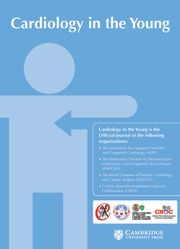Article contents
Cardiac biomarkers in COVID-19: what did we learn?
Published online by Cambridge University Press: 13 September 2024
Abstract
COVID-19, caused by the SARS-CoV-2 virus, has generated a global pandemic with a wide range of clinical manifestations. Cardiovascular complications are frequently observed in individuals with COVID-19, particularly those with preexisting cardiovascular risk factors or diseases. Cardiac biomarkers, including troponin, natriuretic peptides, and inflammatory markers, play a vital role in risk stratification, diagnosis, monitoring, and prognosis in COVID-19 patients. These biomarkers provide valuable insights into cardiac injury, myocardial stress, inflammation, and the prediction of adverse cardiovascular outcomes. This review aims to provide better understanding of how Cardiac biomarkers correlate to clinical manifestation of COVID-19.
We retrieved studies from PubMed, Medline, and Google Scholars that included results on cardiac biomarkers in COVID-19. Total of 14 studies were reviewed.
8 studies showed evidence of poor progression of the disease when there is increased troponin. 6 studies out of the 14 mentioned in this review showed positive correlation between mortality and elevation in cardiac biomarkers. This shows the significance of cardiac biomarkers in predicting the mortality in patients with COVID-19.
It was shown that elevated cardiac biomarkers were associated significantly to poor outcome of covid-19 infection. The outcomes that were linked to increased cardiac biomarkers included increased length of hospitalization, need of life sustaining treatment, myocarditis, invasive and non-invasive respiratory support, and even death were linked to elevated cardiac biomarkers levels.
- Type
- Review
- Information
- Copyright
- © The Author(s), 2024. Published by Cambridge University Press
Footnotes
Lara Srour and Jaafar Ismail are contributed equally to the manuscript.
References
- 1
- Cited by



